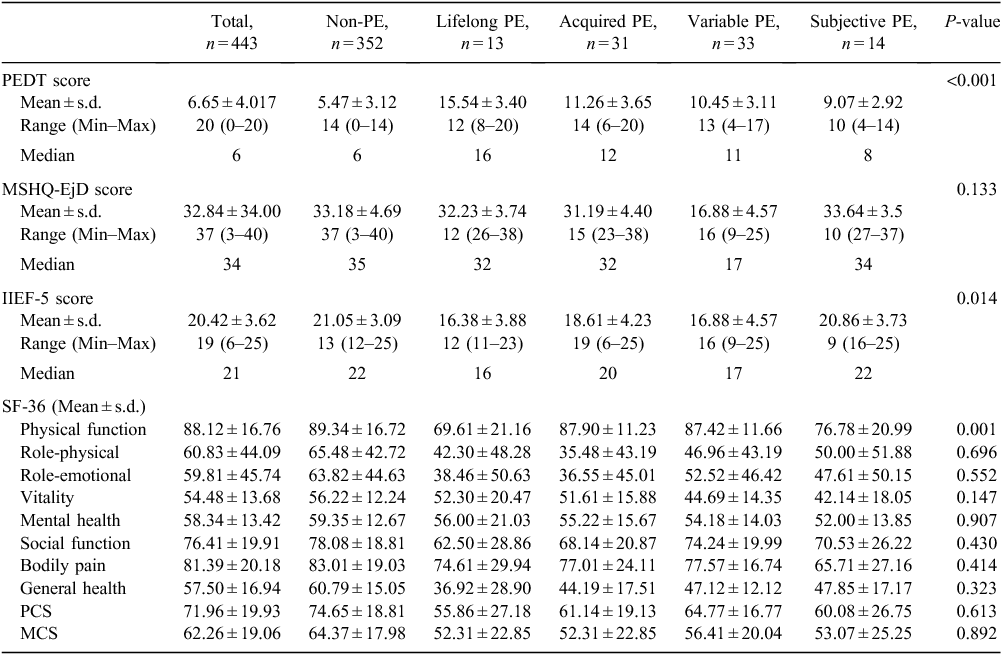Validity of the Premature Ejaculation Diagnostic Tool in four subgroups of premature ejaculation syndrome: data from the Korean Internet Sexuality Survey – part 1
Sang Hoon Song A , Woo Seok Choi B , Hwancheol Son B C D and Jae-Seung Paick BA Department of Urology, Asan Medical Center, University of Ulsan College of Medicine, Seoul 138-736, Republic of Korea.
B Department of Urology, Seoul National University Hospital, Seoul National University College of Medicine, Seoul110-744, Republic of Korea.
C Department of Urology, Boramae Medical Center, Seoul 156-707, Republic of Korea.
D Corresponding author. Email: volley@snu.ac.kr
Sexual Health 11(1) 73-80 https://doi.org/10.1071/SH13171
Submitted: 22 October 2013 Accepted: 8 February 2014 Published: 26 March 2014
Abstract
Background: The premature ejaculation diagnostic tool (PEDT) is a brief, multidimensional validated instrument devised for diagnosing premature ejaculation (PE). However, there is insufficient evidence regarding its ability to differentiate subgroups of PE. We assessed the ability of the PEDT to differentiate four subgroups of PE (lifelong, acquired, variable and subjective PE). Methods: An internet-based survey was conducted with a population-based sample of males aged 20–59 years. Participants were asked to complete a questionnaire requesting detailed medical and sexual histories. The questionnaire including questions from the PEDT and from the Medical Outcome Study Short-form 36-Item Health Survey (SF-36). Using the PEDT, PE was defined as a cutoff score of ≥11. Results: In this study, 443 subjects (mean age 39.3 ± 10.1 years) were included. PEDT-PE prevalence was 14.6%. The proportions of PE subgroups and their mean PEDT scores were: lifelong PE, 2.9% and 15.5; acquired PE, 7.0% and 11.2; variable PE, 7.4% and 10.4; subjective PE, 3.2% and 9.0. PEDT scores were significantly higher in the lifelong PE group than in other the subgroups of PE (P < 0.001). The subjective PE group had the lowest PEDT score, and their physical and mental component scores for the SF-36 were similar to those of non-PE subjects. Conclusions: This population-based cross-sectional survey has demonstrated that the PEDT is not appropriate for research into four subgroups of PE when used in an general male population study, unless the PEDT is combined with an additional questionnaire with specific questions on the four PE subgroups.
Additional keywords: epidemiology, self-report, sexual dysfunction.
Introduction
Premature ejaculation (PE) is a highly prevalent disorder in many cultures,1–3 and there is a substantial amount of evidence that PE has a considerable negative effect on affected individuals in terms of their mental and social wellbeing.4–6 In efforts to properly identify and diagnose subjects with PE, previous studies have used various diagnostic criteria such as the Diagnostic and Statistical Manual of Mental Disorders (DSM) IV Text Revision and the International Society for Sexual Medicine (ISSM) definitions.7,8 Furthermore, several questionnaires, such as the Premature Ejaculation Profile (PEP),9 the Index of Premature Ejaculation (IPE),10 the Male Sexual Health Questionnaire Ejaculatory Dysfunction (MSHQ-EjD)11 and the Premature Ejaculation Diagnostic Tool (PEDT),12 have been validated for the assessment of PE. The PEDT, a brief self-report, is a psychometrically validated measure that can be easily administered to facilitate a diagnosis of PE12 and it has also been validated in Korea.13 However, fewer data have been reported on the PEDT than on the Premature Ejaculation Profile or the Index of Premature Ejaculation,14 probably because the PEDT was released more recently.
Although guidelines have been suggested for the diagnosis of PE,14,15 the aetiology of PE is so poorly understood that no definite, unarguable diagnosis of PE based on self-reported questionnaires has been achieved. However, some researchers made efforts to define PE clearly based on neurobiological and psychological views. Waldinger and Schweitzer proposed a new definition of PE for the upcoming DSM V as a syndrome classifiable into four different categories: lifelong, acquired, natural variable or variable, and premature-like ejaculatory dysfunction or subjective PE.16,17 Furthermore, this classification system has been reported to have implications for the treatment of PE.14,16 Recently, in two series of studies, Serefoglu et al. confirmed the four PE subtypes in a Turkish outpatient urology clinic and in the general male population.18,19 However, the specificity of the PEDT for a diagnosis of PE (50.5%) was much lower than that found in the original validation study (93.1%)12,18. Therefore, more studies are warranted to further investigate the validity of the PEDT for the classification of these four subgroups in other countries.19,20 Although Zhang et al.21 and Gao et al.22 investigated the prevalence of the four PE subtypes in China, no study has been reported in Korea.
In the Korean Internet Sexuality Survey, a population-based study, we employed and compared PEDT scores in the four subgroups of PE syndrome suggested by Waldinger in order to evaluate its diagnostic ability and usefulness for the classification of PE. Differences between the conventional dichotomous classification (lifelong v. acquired) and the four subgroup classifications of PE (lifelong, acquired, variable and subjective PE) were also investigated with respect to general characteristics, sexual histories and health-related quality of life status in the study population.
Materials and methods
Study design and participants
The Korean Internet Sexuality Survey was designed to evaluate the general prevalence of sexual dysfunctions, relevant help-seeking behaviours and health-related quality of life in the younger generation (aged 20–59 years). This population-based cross-sectional study was conducted in March 2011 by utilising previously demonstrated methodology and an internet survey devised by Son and Song.6,23,24 Subjects were recruited from men enrolled with the INR (an internet research company based in Seoul). The research panel represents a national population-based purposive quota sample of men who agreed to participate in internet surveys. We sent invitational emails to 30 000 men in the research panel aged over 20 years with a request that they visited our web portal. Invitees were asked to participate in this survey if they had been involved in sexual activity more than once per month during the previous 6 months and more than once during the previous 4 weeks. Participants were asked to complete a questionnaire requesting detailed medical and sexual histories, and ejaculation-related self-assessments. Subjects taking medications that might have affected ejaculatory function such as antidepressants (selective serotonin reuptake inhibitors, tricyclic antidepressants) or phosphodiesterase type 5 inhibitors were excluded. To exclude unreliable answers, we discarded incomplete answers and those with a response time of less than 20% of the average response time.23,25 Part I of the Korean Internet Sexuality Survey was undertaken to evaluate the diagnostic and classification value of PEDT for PE and its four subgroups, and to characterise the PE population. The study protocol was reviewed by the Institutional Review Board at Seoul National University Boramae Hospital.
Self-administered questionnaires
We structured a series of multiple choice questions for the self-administered questionnaire. Self-assessed PE was evaluated using the question: ‘Which category would you place yourself in? [translated from Korean],’ to which participants responded by selecting one of the following: premature, normal or delayed ejaculation. If the subject chose PE, further questions were asked to enable the classification of PE into conventional dichotomous groups (lifelong v. acquired) and into the four groups of PE (lifelong, acquired, variable and subjective PE). The validated Korean versions of the PEDT, the MSHQ-EjD, the International Index of Erectile Function (five-item version (IIEF-5), the Medical Outcome Study Short-form 36-Item Health Survey (SF-36) and additional self-assessment questions were also asked. The scores of each of the questionnaires were compared with the PEDT definitions of PE (PEDT-PE) and non-PE groups, and among the four PE subgroups.
Definitions of PE and other factors
The PEDT cutoff score for diagnosing PE was set at ≥11, as was proposed by Symonds, the inventor of the PEDT.12 Based on Asian criteria,26 body mass index was classified as normal at <23 kg m–2, overweight at 23–25 kg m–2 and obese at >25 kg m–2. IIEF-5 indices were classified as described by Rosen et al.: a score of ≥22 was classified as normal, 17–21 as mild erectile dysfunction (ED), 12–16 as mildly moderate ED, 8–11 as moderate ED and 5–7 as severe ED.27 The SF-36 is a widely used health status measure.28 It comprises eight health subscales: physical functioning, role – physical, bodily pain, general health, vitality, social functioning, role – emotional and mental health.29 All questions are scored on a scale from 0 to 100, where 100 represents the highest level of functioning possible. The eight subscales are collapsed in order to create two global components: a physical component score and a mental component score (MCS). In the present study, we adopted the Korean version of the SF-36, which was developed and validated by Han et al.30
Statistical analysis
All statistical analyses were performed using SPSS ver. 17.0 (SPSS Inc., Chicago, IL, USA). The χ2-test was used to compare categorical data, and the independent t-test and one-way ANOVA were used to compare numerical data. Binary logistic regression analysis was used to calculate the odds ratios (ORs) of risk factors. All hypotheses were evaluated in a two-sided manner and P-values of <0.05 were considered significant. Values are presented as mean ± s.d.
Results
During the 20-day study period, 1206 individuals opened the invitation email and visited the web portal. After excluding responses from 573 participants due to incomplete answers and 190 for too short a response time or for meeting exclusion criteria, 443 subjects were finally included in the analysis – a response rate of 36.7%. The mean participant age was 39.3 ± 10.1 years and the average frequency of sexual intercourse was 5.6 ± 4.5 times per month. The general characteristics of the study population are summarised in Table 1. The prevalence of self-reported PE was 20.5% and this increased with age and was greatest in men in their 50s. Percentages with ED (mildly moderate to severe ED) also increased with age (4.5%, 11.2%, 13.2% and 32.7% in men in their 20s, 30s, 40s and 50s, respectively). The amount of aerobic exercise per month was inversely associated with the rate of PE (Table 1). However, by multivariate analysis, ED (OR = 2.59, 95% confidence interval: 1.53–4.39; P < 0.001) and an unmarried status (OR = 2.19, 95% confidence interval: 1.17–4.13; P = 0.014) were the only predictors of self-reported PE. When we selected patients without ED (IIEF-5 score ≥ 22, n = 207), there was no association between age and self-reported PE rate (Fisher’s exact test, P = 0.772).
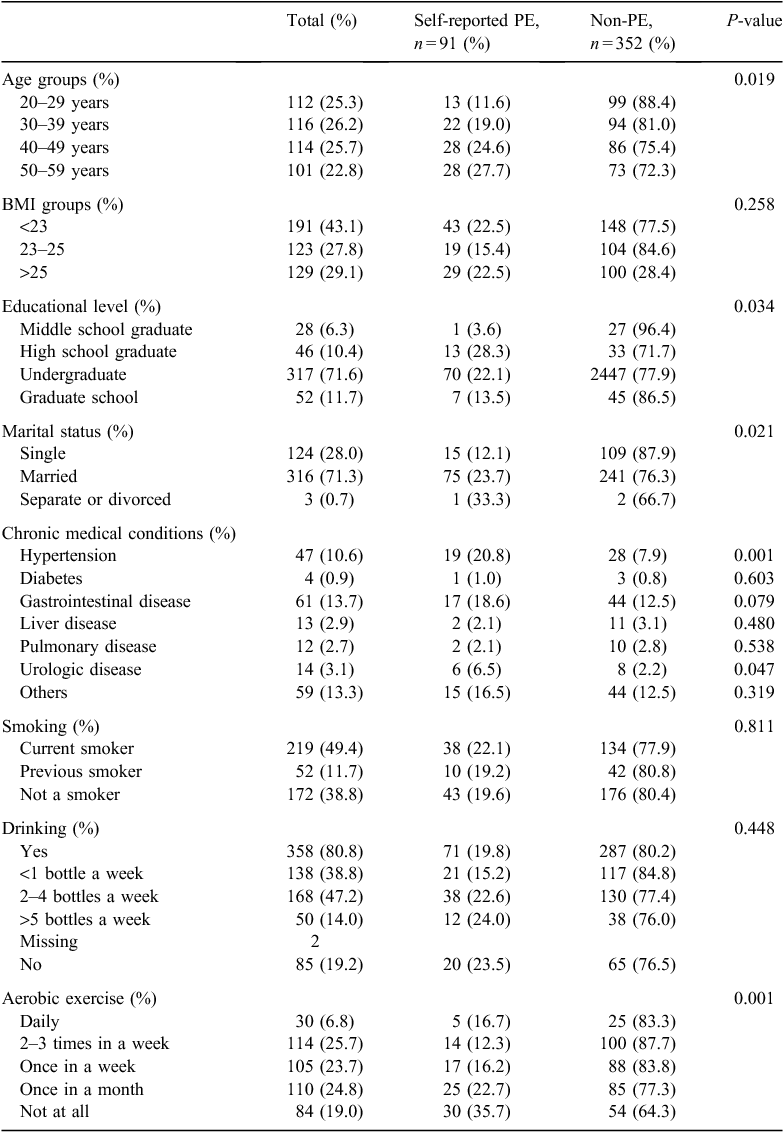
|
The rate of PE was found to be variable depending on the type of definition used (Fig. 1). Self-reported PE was found to have the highest rate (20.5%) in all study subjects, although it was similar to that of PE defined by the self-reported intravaginal ejaculation latency time (IELT) 5-min cutoff (18.7%). Regarding the types of self-reported PE, variable PE had the highest rate (7.4%) and lifelong PE the lowest (2.9%). When we applied the self-reported IELT 1-min cutoff, the rate of PE in the study population was only 1.1%.
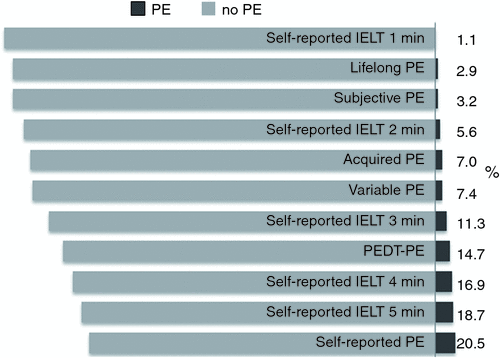
|
Applying the PEDT definition, we found a PE rate of 14.6% among all 443 study subjects. MSHQ-EjD and SF-36 domain scores were also significantly different in the PEDT-PE and non-PE groups (Table 2). The PEDT-PE group had a slightly higher mean age than the non-PE group (41.6 years v. 38.9 years, respectively; P = 0.047) and their self-reported IELT was shorter than that of the non-PE group (4.3 v. 13.6 min, respectively; P < 0.001). A lower percentage of PEDT-PE was noted in men who consumed alcohol than in those who did not drink (6.9 v. 17.8%; P = 0.006), although no dose–response relationship was found between alcohol consumption and PE. When we analysed PE rates after eliminating the acquired PE group from the analysis, almost no difference was found between alcohol consumers and nonconsumers (14.5% and 14.6%; P = 1.00).
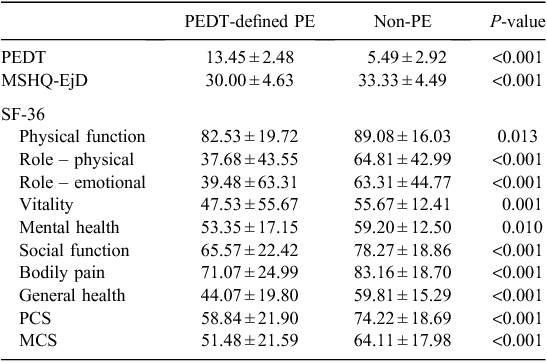
|
Contrary to a lack of difference in MSHQ-EjD scores, significant differences in PEDT scores were found across the PE subgroups. PEDT scores were significantly higher in the lifelong PE group and lower in the subjective PE group than in the other subgroups of PE (Table 3, Fig. 2). In the variable and subjective PE groups, although the PEDT mean was higher than that in the total population, mean scores were lower than 11, the cutoff score used for the PEDT-PE definition.
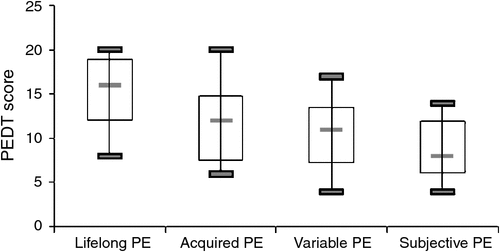
|
We examined the diagnostic power of PEDT for the detection of self-reported lifelong PE using receiver operating characteristic curve analysis. Sensitivity and specificity were 91.3% and 93.8%, respectively, using a PEDT cutoff score of 11, and were 91.3% and 80.5%, respectively, using a PEDT cutoff score of 9 (Fig. 3). Using the PEDT-PE definition, we found a significant difference between the two subgroups in the conventional dichotomous (lifelong or acquired) classification and among Waldinger’s four subgroups of PE by cross-table analysis (Fisher’s exact test, P < 0.001 and 0.002, respectively). However, a PEDT cutoff score of 9 was not found to be useful for classifying PE dichotomously (lifelong or acquired) or for classification into Waldinger’s four subgroups by cross-table analysis (Fisher’s exact test, P = 0.53 and 0.55, respectively).
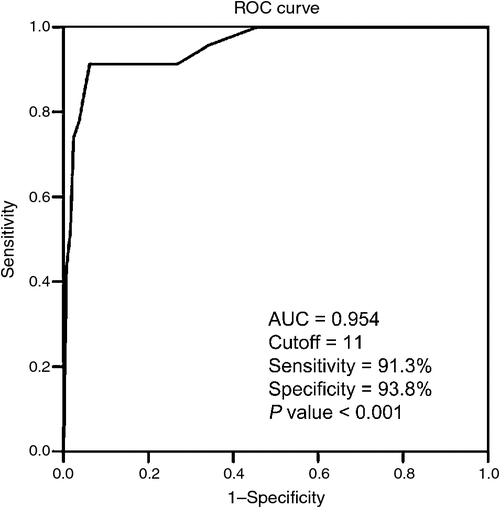
|
All SF-36 domain scores were significantly different between the PEDT-PE and non-PE groups (Tables 2, 3). However, no differences in domain scores were found across the PE subgroups except for the physical function domain (Table 3).
Personal attitude towards sexual activity and relationship between the subject and his partner were evaluated using two self-assessment questions. Of the four subgroups of Waldinger’s PE, subjects in the subjective PE group talked to their partners about their problems about sex more often than those in the lifelong PE group (P = 0.048, ANOVA with Tukey’s post hoc analysis). Furthermore, the subjective PE group showed a more positive attitude towards sexual activity than the other subgroups (P = 0.035, ANOVA with Tukey’s post hoc analysis).
By multiple logistic regression analysis, ED, not consuming alcohol and a low physical component score remained significant predictors of PEDT-PE (Table 4).

|
Discussion
This is the first cross-sectional study to compare PEDT scores with Waldinger’s four subgroups of PE (lifelong, acquired, variable and subjective PE) to assess the ability of PEDT scores to differentiate subgroups of PE. Lifelong PE is a chronic ejaculatory dysfunction characterised by symptom clusters as follows: ejaculation occurs too early at nearly every intercourse, with nearly every woman, from about the first sexual encounters onwards, within 30–60s in the majority of cases or 1–2 min, and remains rapid during life.7,31 Acquired PE is characterised by the following symptoms: early ejaculation occurs at some point in a man’s life, the man has usually had normal ejaculation experiences before the start of complaints and there is a sudden or gradual onset.31 Men with variable PE only experience early ejaculation coincidentally and situationally. Variable PE should not be regarded as a symptom or manifestation of true pathology but of normal variation in sexual performance.31 In subjective PE, men experience or complain of PE although the ejaculation time is in the normal range (i.e. ~3–6 min) and may even be of very long duration (i.e. 5–25 min). Subjective PE should not be regarded as a symptom or manifestation of true medical pathology. Psychological or relationship problems may underlie the complaints.31
We sought to determine the characteristics of PEDT-PE in Korea. Several earlier studies have reported the prevalence and characteristics of PE patients in Korea, but these studies did not apply a detailed classification of PE.3,6,13,23 In the present study, we found that mean PEDT scores were significantly higher in lifelong PE and lower in the subjective PE group than the cutoff value for PE definition. Such differences across PE subgroups support the recently suggested four-subtype classification of Waldinger32 and the treatment strategy of the ISSM.14 Use of the PEDT may enable clinicians to easily differentiate PE patients who need pharmacotherapy rather than behavioural therapy or psychotherapy (i.e. between those with lifelong or acquired PE, and those with variable PE or subjective PE).
In variable PE, men only occasionally suffer from early ejaculation.32–34 Variable PE should be regarded as part of the normal variability of ejaculatory performance and not a symptom of pathology.
The PEDT was developed to capture the essence of the DSM-IV-TR by incorporating five questions that measure control, frequency, minimal stimulation, distress and interpersonal difficulties relevant to ejaculation. In other words, it does not directly reflect IELT. However, the recent definition of PE suggested by the ISSM adopted an IELT cutoff of 1 min.7 Furthermore, it was recommended that ‘self-estimation by the patient and partner of ejaculatory latency be accepted as the method for determining IELT in clinical practice’14. The IELT cutoff of 1 min is expected to be included in the upcoming version of the DSM (DSM-V), as was proposed by Waldinger.16 Therefore, the PEDT alone might be inadequate for diagnosing the time-related characteristics of PE.
We administered the PEDT to diagnose PE in our study population using a cutoff score of 11. This cutoff score was suggested by the inventor of the PEDT and was also validated in Korean PE cohorts12,13. The authors of both studies recommended that a PEDT score of 9 and 10 be classified as ‘probable PE,’ based on sensitivity and specificity analysis. The value of this diagnostic grey zone was also non-negligible in the present study, because we found identical sensitivity and slightly lower, but still considerable, specificity for cutoff scores of 9, 10 and 11 for defining PE by ROC curve analysis (Fig. 1). Nevertheless, this ‘probable PE’ definition was not valuable for classifying PE. Therefore, we consider that a PEDT cutoff score of ≥11 provides clinicians more information than a cutoff score of ≥9 does for classifying PE.
In epidemiological studies, PE has been found to be the most common sexual complaint in males and to affect ~20–30% of males in all age groups.1,2,35 Such a high prevalence of PE presumably represents the high percentage of men with ‘complaints’ of PE.31 Similarly a high prevalence of self-reported PE was also observed in the Korean population in two surveys23,36 and in the present study. However, the prevalence of PE depended on the definition of PE used, as shown in Fig. 1. These results concur with those of previous reports, namely that the use of IELT alone to define PE do not fully capture the subjective aspects of the disorder.9,23 The prevalence rates of PE have already been predicted to be different whether a general male population is investigated or whether a clinical population is investigated, as suggested by Waldinger and confirmed by Serofoglu and the Chinese investigators.16,19,21,22 Nevertheless, it is noteworthy that the rate of PE using a 1-min cutoff of self-reported IELT was the lowest and close to that of self-reported lifelong PE. Thus we speculate that self-reported IELT could be useful for determining lifelong PE, although not all subjects that complain of PE are likely to be included.
The SF-36 has been proven to be useful for comparing general and specific populations, for estimating the relative burdens of different diseases, for differentiating the health benefits produced by a wide range of different treatments and for screening individual patients.37 Using this validated questionnaire, we found that all domains, mental and physical, were significantly different in the PE and non-PE groups, regardless of whether we applied the self-reported definition or the PEDT definition. This result concurs with previous studies on the psychological burden of PE.4–6 Notably, self-assessed physical function scores were lower in PE groups, and these men had significantly lower levels of physical activity, especially aerobic exercise. Although we could not find a causal relationship between the amount of physical activity and physical function scores, we did find a suggestion of a correlation between low levels of physical activity and self-awareness of poor physical health status in terms of PE. Thus, further objective studies on physical function could confirm any relationships between physical function and physical activity in both PE and non-PE subjects.
One interesting aspect of sexual attitudes was noted during our analysis: no differences were observed between the four PE groups in terms of overall health-related quality of life as assessed by the physical component score and the mental component score in SF-36. However, subjects in the subjective PE group were found to talk to their partners about sexually related problems more often than those in the lifelong PE group. Furthermore, this group of subjects showed more positive attitudes towards sexual activity than others. In other words, they seemed to adopt franker and more assertive standpoints regarding sexual matters. In addition to this social and psychological activeness, their physical status was also comparatively higher in that they were better able to control ejaculation. Overall, subjects in the subjective PE group considered themselves PE sufferers despite their physical and mental adequacies.
This study has several limitations. First, there are concerns of selection bias in terms of choosing the study population. For example, because this study was based on an internet survey, our cohort may have been biased towards users with higher educational and socioeconomic profiles. In addition, the low response rate (36.7%) also raises the issue of predisposition to selection bias, although this level of response rate was not unexpected and was similar to those of other internet survey-based studies.6,23 Furthermore, the prevalence of PE (PEDT-PE) found in the present study is similar to previously reported values.1,2,35 Second, we divided subjects into subgroups according to Waldinger’s classification system, which is based exclusively on self-assessment. Thus, in order to classify subjects more reliably, a further study incorporating a face-to-face interview is warranted. Finally, the number of respondents in each of the subgroups might be insufficient to be representative of each PE syndrome. However, we believe that our result scan strengthen the knowledge about PE as it provides some population-based data on PE.
Conclusions
This population-based cross-sectional survey investigated the validity of the PEDT as a diagnostic tool for the differentiation of subgroups of PE. The current study has demonstrated that the PEDT is not appropriate to capture all men with subjective PE when used in an epidemiological general male population study. The PEDT alone is therefore not suitable for research of Waldinger’s four PE subtypes, unless the PEDT is combined with an additional questionnaire with specific questions on the four PE subtypes, as has been performed in the current study.
Conflicts of interest
None declared.
Acknowledgements
All statistical analyses were carried out under consultation with medical statisticians at the Medical Research Collaborating Center at Seoul National University College of Medicine.
References
[1] Laumann EO, Nicolosi A, Glasser DB, Paik A, Gingell C, Moreira E, et al Sexual problems among women and men aged 40–80 y: prevalence and correlates identified in the Global Study of Sexual Attitudes and Behaviors. Int J Impot Res 2005; 17 39–57.| Sexual problems among women and men aged 40–80 y: prevalence and correlates identified in the Global Study of Sexual Attitudes and Behaviors.Crossref | GoogleScholarGoogle Scholar | 15215881PubMed |
[2] Porst H, Montorsi F, Rosen RC, Gaynor L, Grupe S, Alexander J. The Premature Ejaculation Prevalence and Attitudes (PEPA) survey: prevalence, comorbidities, and professional help-seeking. Eur Urol 2007; 51 816–24.
| The Premature Ejaculation Prevalence and Attitudes (PEPA) survey: prevalence, comorbidities, and professional help-seeking.Crossref | GoogleScholarGoogle Scholar | 16934919PubMed |
[3] Park HJ, Park JK, Park K, Lee SW, Kim S-W, Yang DY, et al Prevalence of premature ejaculation in young and middle-aged men in Korea: a multicenter internet-based survey from the Korean Andrological Society. Asian J Androl 2010; 12 880–9.
| Prevalence of premature ejaculation in young and middle-aged men in Korea: a multicenter internet-based survey from the Korean Andrological Society.Crossref | GoogleScholarGoogle Scholar | 20676115PubMed |
[4] Symonds T, Roblin D, Hart K, Althof S. How does premature ejaculation impact a man s life? J Sex Marital Ther 2003; 29 361–70.
| How does premature ejaculation impact a man s life?Crossref | GoogleScholarGoogle Scholar | 14504007PubMed |
[5] Rowland DL, Patrick DL, Rothman M, Gagnon DD. The psychological burden of premature ejaculation. J Urol 2007; 177 1065–70.
| The psychological burden of premature ejaculation.Crossref | GoogleScholarGoogle Scholar | 17296413PubMed |
[6] Son H, Song SH, Lee JY, Paick JS. Relationship between premature ejaculation and depression in Korean males. J Sex Med 2011; 8 2062–70.
| Relationship between premature ejaculation and depression in Korean males.Crossref | GoogleScholarGoogle Scholar | 21235722PubMed |
[7] McMahon CG, Althof SE, Waldinger MD, Porst H, Dean J, Sharlip ID, et al An evidence-based definition of lifelong premature ejaculation: report of the International Society for Sexual Medicine (ISSM) ad hoc committee for the definition of premature ejaculation. J Sex Med 2008; 5 1590–606.
| An evidence-based definition of lifelong premature ejaculation: report of the International Society for Sexual Medicine (ISSM) ad hoc committee for the definition of premature ejaculation.Crossref | GoogleScholarGoogle Scholar | 18466262PubMed |
[8] McMahon CG. The DSM-IV-TR definition of premature ejaculation and its impact upon the results of epidemiological studies. Eur Urol 2008; 53 887–9.
| The DSM-IV-TR definition of premature ejaculation and its impact upon the results of epidemiological studies.Crossref | GoogleScholarGoogle Scholar | 18083296PubMed |
[9] Patrick DL, Althof SE, Pryor JL, Rosen R, Rowland DL, Ho KF, et al Premature ejaculation: an observational study of men and their partners. J Sex Med 2005; 2 358–67.
| Premature ejaculation: an observational study of men and their partners.Crossref | GoogleScholarGoogle Scholar | 16422867PubMed |
[10] Althof S, Rosen R, Symonds T, Mundayat R, May K, Abraham L. Development and validation of a new questionnaire to assess sexual satisfaction, control, and distress associated with premature ejaculation. J Sex Med 2006; 3 465–75.
| Development and validation of a new questionnaire to assess sexual satisfaction, control, and distress associated with premature ejaculation.Crossref | GoogleScholarGoogle Scholar | 16681472PubMed |
[11] Rosen RC, Catania JA, Althof SE, Pollack LM, O’Leary M, Seftel AD, et al Development and validation of four-item version of Male Sexual Health Questionnaire to assess ejaculatory dysfunction. Urology 2007; 69 805–9.
| Development and validation of four-item version of Male Sexual Health Questionnaire to assess ejaculatory dysfunction.Crossref | GoogleScholarGoogle Scholar | 17482908PubMed |
[12] Symonds T, Perelman MA, Althof S, Giuliano F, Martin M, May K, et al Development and validation of a premature ejaculation diagnostic tool. Eur Urol 2007; 52 565–73.
| Development and validation of a premature ejaculation diagnostic tool.Crossref | GoogleScholarGoogle Scholar | 17275165PubMed |
[13] Kam SC, Han DH, Lee SW. The diagnostic value of the Premature Ejaculation Diagnostic Tool and its association with intravaginal ejaculatory latency time. J Sex Med 2010;
| The diagnostic value of the Premature Ejaculation Diagnostic Tool and its association with intravaginal ejaculatory latency time.Crossref | GoogleScholarGoogle Scholar | 21143424PubMed |
[14] Althof SE, Abdo CH, Dean J, Hackett G, McCabe M, McMahon CG, et al International Society for Sexual Medicine’s guidelines for the diagnosis and treatment of premature ejaculation. J Sex Med 2010; 7 2947–69.
| International Society for Sexual Medicine’s guidelines for the diagnosis and treatment of premature ejaculation.Crossref | GoogleScholarGoogle Scholar | 21050394PubMed |
[15] Hatzimouratidis K, Amar E, Eardley I, Giuliano F, Hatzichristou D, Montorsi F, et al Guidelines on male sexual dysfunction: erectile dysfunction and premature ejaculation. Eur Urol 2010; 57 804–14.
| Guidelines on male sexual dysfunction: erectile dysfunction and premature ejaculation.Crossref | GoogleScholarGoogle Scholar | 20189712PubMed |
[16] Waldinger MD, Schweitzer DH. Changing paradigms from a historical DSM-III and DSM-IV view toward an evidence-based definition of premature ejaculation. Part II – proposals for DSM-V and ICD-11. J Sex Med 2006; 3 693–705.
| Changing paradigms from a historical DSM-III and DSM-IV view toward an evidence-based definition of premature ejaculation. Part II – proposals for DSM-V and ICD-11.Crossref | GoogleScholarGoogle Scholar | 16839326PubMed |
[17] Waldinger MD. History of premature ejaculation. In EA Jannini CM, MD Waldinger, editors. Premature ejaculation from etiology to diagnosis and treatment. Italia: Springer; 2013. pp. 5–24.
[18] Serefoglu EC, Yaman O, Cayan S, Asci R, Orhan I, Usta MF, et al The comparison of premature ejaculation assessment questionnaires and their sensitivity for the four premature ejaculation syndromes: results from the Turkish Society of Andrology Sexual Health Survey. J Sex Med 2011; 8 1177–85.
| The comparison of premature ejaculation assessment questionnaires and their sensitivity for the four premature ejaculation syndromes: results from the Turkish Society of Andrology Sexual Health Survey.Crossref | GoogleScholarGoogle Scholar | 21269396PubMed |
[19] Serefoglu EC, Yaman O, Cayan S, Asci R, Orhan I, Usta MF, et al Prevalence of the complaint of ejaculating prematurely and the four premature ejaculation syndromes: results from the Turkish Society of Andrology Sexual Health Survey. J Sex Med 2011; 8 540–8.
| Prevalence of the complaint of ejaculating prematurely and the four premature ejaculation syndromes: results from the Turkish Society of Andrology Sexual Health Survey.Crossref | GoogleScholarGoogle Scholar | 21054799PubMed |
[20] Waldinger MD. Toward evidence-based genetic research on lifelong premature ejaculation: a critical evaluation of methodology. Korean Journal of Urology 2011; 52 1–8.
| Toward evidence-based genetic research on lifelong premature ejaculation: a critical evaluation of methodology.Crossref | GoogleScholarGoogle Scholar | 21344023PubMed |
[21] Zhang X, Gao J, Liu J, Xia L, Yang J, Hao Z, et al Distribution and factors associated with four premature ejaculation syndromes in outpatients complaining of ejaculating prematurely. J Sex Med 2013; 10 1603–11.
| Distribution and factors associated with four premature ejaculation syndromes in outpatients complaining of ejaculating prematurely.Crossref | GoogleScholarGoogle Scholar | 23534914PubMed |
[22] Gao J, Zhang X, Su P, Liu J, Xia L, Yang J, et al Prevalence and factors associated with the complaint of premature ejaculation and the four premature ejaculation syndromes: a large observational study in China. J Sex Med 2013; 10 1874–81.
| Prevalence and factors associated with the complaint of premature ejaculation and the four premature ejaculation syndromes: a large observational study in China.Crossref | GoogleScholarGoogle Scholar | 23651451PubMed |
[23] Son H, Song SH, Kim SW, Paick JS. Self-reported premature ejaculation prevalence and characteristics in Korean young males: community-based data from an internet survey. J Androl 2010; 31 540–6.
| Self-reported premature ejaculation prevalence and characteristics in Korean young males: community-based data from an internet survey.Crossref | GoogleScholarGoogle Scholar | 20671139PubMed |
[24] Song SH, Jeon H, Kim SW, Paick JS, Son H. The prevalence and risk factors of female sexual dysfunction in young Korean women: an internet-based survey. J Sex Med 2008; 5 1694–701.
| The prevalence and risk factors of female sexual dysfunction in young Korean women: an internet-based survey.Crossref | GoogleScholarGoogle Scholar | 18422495PubMed |
[25] Son H, Song SH, Lee JY, Paick JS. Relationship between premature ejaculation and depression in Korean males. J Sex Med 2011; 8 2062–70.
| Relationship between premature ejaculation and depression in Korean males.Crossref | GoogleScholarGoogle Scholar | 21235722PubMed |
[26] Choo V. WHO reassesses appropriate body-mass index for Asian populations. Lancet 2002; 360 235
| WHO reassesses appropriate body-mass index for Asian populations.Crossref | GoogleScholarGoogle Scholar | 12133671PubMed |
[27] Rosen RC, Cappelleri JC, Smith MD, Lipsky J, Pena BM. Development and evaluation of an abridged, 5-item version of the International Index of Erectile Function (IIEF-5) as a diagnostic tool for erectile dysfunction. Int J Impot Res 1999; 11 319–26.
| Development and evaluation of an abridged, 5-item version of the International Index of Erectile Function (IIEF-5) as a diagnostic tool for erectile dysfunction.Crossref | GoogleScholarGoogle Scholar | 10637462PubMed |
[28] Ware JE, Sherbourne CD. The MOS 36-item short-form health survey (SF-36). I. Conceptual framework and item selection. Med Care 1992; 30 473–83.
| The MOS 36-item short-form health survey (SF-36). I. Conceptual framework and item selection.Crossref | GoogleScholarGoogle Scholar | 1593914PubMed |
[29] Ware JE, Snow KK, Kosisnki M, Gandek B. SF-36 health survey manual and interpretation guide. Boston: The Health Institute, New England Medical Center; 1993.
[30] Han CW, Lee EJ, Iwaya T, Kataoka H, Kohzuki M. Development of the Korean version of short-form 36-item health survey: health related QOL of healthy elderly people and elderly patients in Korea. Tohoku J Exp Med 2004; 203 189–94.
| Development of the Korean version of short-form 36-item health survey: health related QOL of healthy elderly people and elderly patients in Korea.Crossref | GoogleScholarGoogle Scholar | 15240928PubMed |
[31] Waldinger MD, Schweitzer DH. Re: Francois Giuliano, Donald L. Patrick, Hartmut Porst, et al. for the 3004 study group. Premature ejaculation: results from a five-country European observational study. Eur Urol 2008;53:1048–57. Eur Urol 2008; 53 1304–5.
| Re: Francois Giuliano, Donald L. Patrick, Hartmut Porst, et al. for the 3004 study group. Premature ejaculation: results from a five-country European observational study. Eur Urol 2008;53:1048–57.Crossref | GoogleScholarGoogle Scholar | 18262333PubMed |
[32] Waldinger MD, Schweitzer DH. The use of old and recent DSM definitions of premature ejaculation in observational studies: a contribution to the present debate for a new classification of PE in the DSM-V. J Sex Med 2008; 5 1079–87.
| The use of old and recent DSM definitions of premature ejaculation in observational studies: a contribution to the present debate for a new classification of PE in the DSM-V.Crossref | GoogleScholarGoogle Scholar | 18331260PubMed |
[33] Waldinger MD. Premature ejaculation: state of the art. Urol Clin North Am 2007; 34 591–9.
| Premature ejaculation: state of the art.Crossref | GoogleScholarGoogle Scholar | 17983899PubMed |
[34] Waldinger MD, Schweitzer DH. Changing paradigms from a historical DSM-III and DSM-IV view toward an evidence-based definition of premature ejaculation. Part I – validity of DSM-IV-TR. J Sex Med 2006; 3 682–92.
| Changing paradigms from a historical DSM-III and DSM-IV view toward an evidence-based definition of premature ejaculation. Part I – validity of DSM-IV-TR.Crossref | GoogleScholarGoogle Scholar | 16839325PubMed |
[35] Rowland D, Perelman M, Althof S, Barada J, McCullough A, Bull S, et al Self-reported premature ejaculation and aspects of sexual functioning and satisfaction. J Sex Med 2004; 1 225–32.
| Self-reported premature ejaculation and aspects of sexual functioning and satisfaction.Crossref | GoogleScholarGoogle Scholar | 16429622PubMed |
[36] Park HJ, Park JK, Park K, Lee SW, Kim SW, Yang DY, et al Prevalence of premature ejaculation in young and middle-aged men in Korea: a multicenter internet-based survey from the Korean Andrological Society. Asian J Androl 2010; 12 880–9.
| Prevalence of premature ejaculation in young and middle-aged men in Korea: a multicenter internet-based survey from the Korean Andrological Society.Crossref | GoogleScholarGoogle Scholar | 20676115PubMed |
[37] Manocchia M, Bayliss MS, Connor J, Keller SD, Shiely J-C, Tasai C, et al. SF-36 health survey annotated bibliography: 2nd edn. Boston, MA: The Health Assessment Lab, New England Medical Center; 1998.


